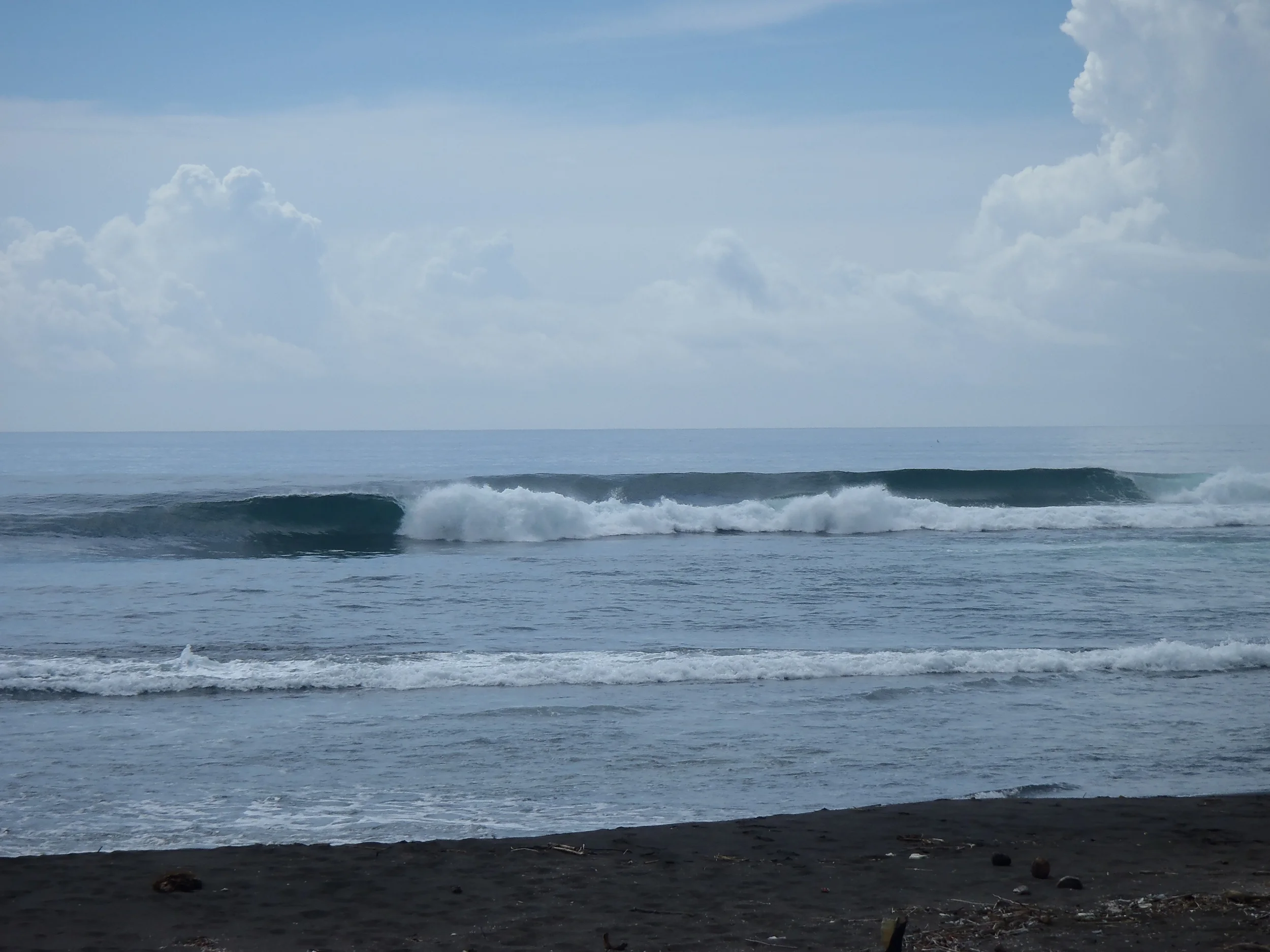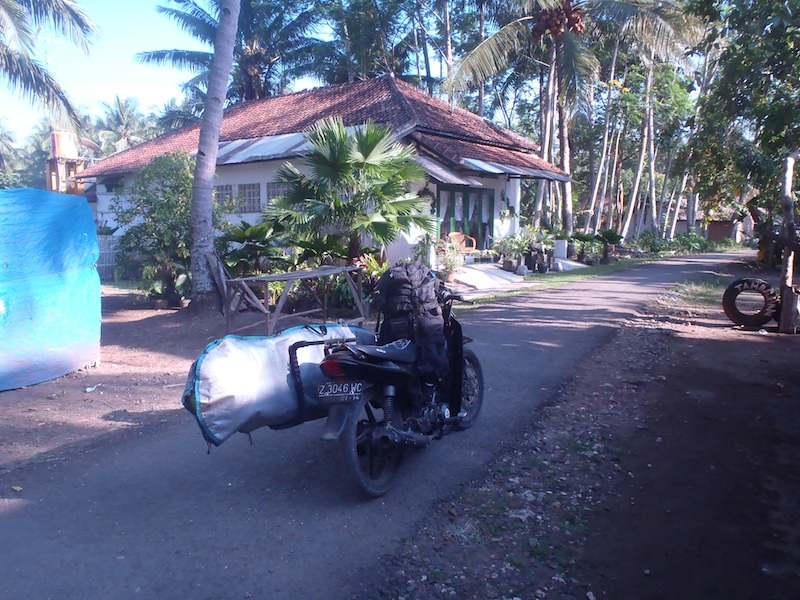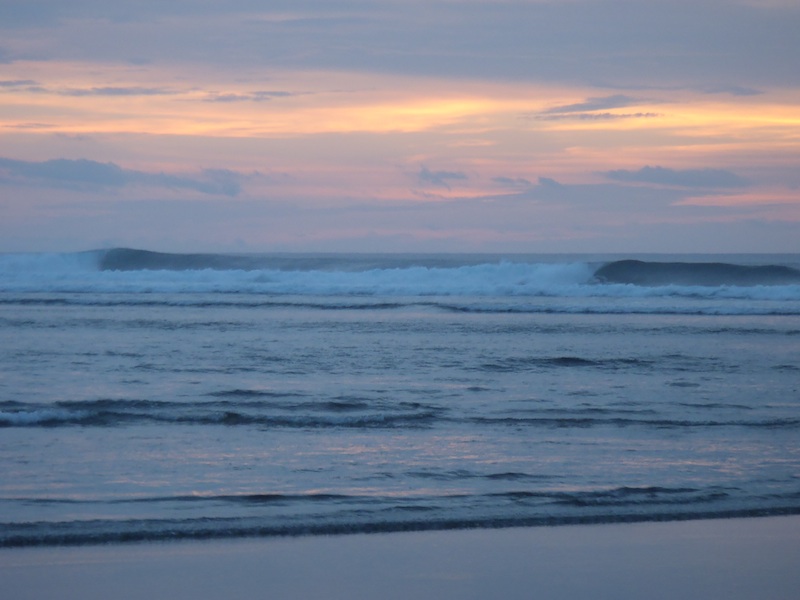We’re warned of tigers. Of waves that gulp fishing boats and a malarial jungle you can hear breathe from the surf. We’ve heard it’s a left. We’ve heard it’s like Sawarna, Airports, Green Island on steroids; we’ve heard it holds it big. There’s rumours of other waves in the area, confirmed by glimpses between coconut palms and pyramids of black sand, but then, this wave too, this West Javan gem, is more rumour than actuality, is more often murmured about in tourist-town warungs than surfed.
Everyone seems to play down the road. “Three, three and a half hours,” we’re told. “Max.”
Maybe this is because last dry season foreign companies hadn’t started to buy up rice paddies and turn them inside out, draw out the roots of coconut palms like bones, leave gutted earth, black sink ponds. The mining is impossible to ignore. Dust from an endless convoy of trucks glues to our teeth, our clothes are whipped dark with exhaust and even the trees on either side are colourless. Every time we hit a pothole my neighbour Sapri, who won the Rip Curl Grom Search in our village a few years ago, groans then shouts, “Air show!” Unlike Sapri’s air shows out at our local, precisely timed and graceful (he’s even managed an air on my 6’4!), my air shows on the motorbike nearly shatter our tailbones. Sapri offers to ride my bike for me, suggests maybe I should sit on the back.
“No chance!” I tell him.
So it’s four and a half hours of this and then comes the last part of the ride. This bit was always a challenge, even before the sand mining. There’s a river. The only way to cross is to launch up a motorbike-wheel width of bamboo onto a flat wooden raft. My partner Tom goes first, gunning the bike and nearly flying off the other side. Then the boys give it a crack. The boys are a couple of mates from Australia who are staying with us, glutted from a Lakey mission and prepared to risk their last week of annual leave on a more fickle lick of Indonesian coast. So with Tom, Sapri, myself and the boys, there’s five of us. And no one ends up in the drink. Until the second river. The crossing here is unpredictable, depends on whether there’s been rain and on the surge of the tide. We make it through with wet knees, skidding and dovetailing in the sand. We can see it now, this legendary left hand wave, low tide and broken but with a formidable, promising shape.
Our first stop is the line of fishing huts. We need to ask permission to sleep on our board bags at the edge of the jungle. None of us have a tent. “No way,” says Agus, the head fisherman. “Nggak. Nggak boleh tidur di sana. You may not sleep there.” There’s a paralysing moment of doubt. The closest accommodation is a lightless hotbox back over the two rivers. Or a half-hour drive further west along the coast. The tide is filling in. The fishermen searching for sea snails on the rocks are swept back to the sand. The air is a diffuse late afternoon gold of salt and sunlight. The wave is starting to show some shape and in half an hour we want to be paddling out between the fishing boats, un-snagging our fins on anchor ropes, avoiding sea urchins with our fingertips, eyes ahead, eyes on the horizon.
So we share looks of panic. Then Agus says, “You may sleep here instead. It’s not safe over there.”
“Because of the tigers,” a woman adds.
“Tigers!”
So we set up. In two huts with tin rooves, elevated from the sand, no walls, just wooden boards to sleep on, drink coffee off, sit on, smoke on, watch the tides move in and out from. And that afternoon we get a taste of how it’s supposed to be. The boys are comfortable and paddle deep; I sit a little off the take off point and wonder what the wave is really capable of, worry about those Indonesian sneaker sets on dusk that wipe everyone out, those sets that double and treble and blot out the sunsets and volcanoes. There’s always that back-of-the-mind fear in Indo, and whether you’re comfortable in four-foot sets and then the eight-footers come, or in the eight-foot sets until a couple of twelve-footers slip through, you’ll find yourself challenged at some stage. I listen to the building hum of the jungle, watch a storm blacken over the mountains, pick off a couple. It behaves like a normal wave, starts big, gets smaller, the paddle out is inconsequential, no shut downs half way along, no surgeon’s slabs where the wave sucks dry off the reef. I sit deeper.
Later on, we cook rice noodles and canned fish (the irony does not escape us, being in a fishing village eating canned fish). I watch as the woman who had warned us of tigers gives her sons packet biscuits for dinner. The packets are smaller than her sons’ tiny fists. While I do our dishes, full of guilt, I cringe. The ground beneath my thongs is a patchwork of plastic.
On the second day it’s pumping. We laugh and whoop each other in. “Last time I was here,” Sapri tells me, “No laughing. No smiling, no joking. Just focus.”
I can imagine. But today, it’s not that serious. The swell is a good period and between sets, I loll on my belly, let my racing heart still, marvel at the ice green water. I can’t believe our luck! There’s no losmen, no board repair shops, no bars, no bules, no circus of photographers.
As the tide drains and our stomachs go acid with hunger we’re forced in. I manage to scrape up my fins and put another hole in my board but the boys fare better. The Ibu with the young sons meets me on the sand with my towel. “Banyak orang,” she says. There’s heaps of people up there. I take the hint and cover up. Not heaps of people but heaps of blokes, fishermen with delicious, dirty, piss taking humour. When we’re all in we brew up a coffee for the fishermen, wait until after they take their first unsugared sips, then ask how it is. One of the men responds with rising finger at his crotch, “Weeewww!”
Agus tells us, with a kind of reverence, about a group of Afghans who had passed through last year. “Sembilan puluh orang,” he says. Ninety people. Children, they had children. The women were beautiful. They were all polite and we prayed together. I can imagine it, can imagine as the soaring maghrib, the late afternoon prayer, swells from one of the fishermen’s mobile phones; there’s no mosque at the edge of the jungle. The Afghans were headed to Australia. On one of the boats that flip and splinter in the dry season, in the monstrous swells that close out the fishing channel. Did they make it? we wonder.
On the slack of the tide we watch a fisherman smoke a cigarette in a pair of tiny red undies and a leather jacket to the wrists. We watch the woman’s two little boys, mullets identical to their dad’s, throw pieces of fishing line off a low wall of sandbags, mimicking, pretending to fish. It’s a life not theirs by choice but by circumstance.
And so perhaps that’s why eventually you must give these places names. Even when you’d prefer to keep the wave a secret, a last frontier. Because the people here eat once or twice a day, because their children have swollen hungry bellies, because money from surf tourism, while it destroys what it loves, is also used to nourish, to educate, to buy medicine with. So this left-hander has a name. Cir Jeruk. And when I ask the woman again about the tigers she tells me she’s lying.
No tigers here, she says. Not for years.
Originally published on the Treehouse Landscapes and Handshapes blog.




